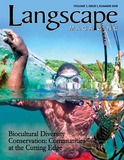| dc.contributor.author | Nemogá, Gabriel | |
| dc.contributor.author | Domicó, Justico | |
| dc.contributor.author | Molina, Alejandro | |
| dc.date.accessioned | 2018-07-25T16:47:49Z | |
| dc.date.available | 2018-07-25T16:47:49Z | |
| dc.date.issued | 2018 | |
| dc.identifier.citation | Nemogá, Gabriel, Justico Domicó, and Alejandro Molina. "Designing Biocultural Protocols with the Embera People of Colombia." Landscape Magazine, vol. 7, no. 1 (Summer 2018): 20-24. | en_US |
| dc.identifier.issn | 2371-3291 | |
| dc.identifier.uri | http://hdl.handle.net/10680/1549 | |
| dc.description.abstract | In Colombia's recent history, the Embera people are one of the Indigenous groups most impacted by forced displacement and violence. Along with other Indigenous nations, such as the Wananni, Guandule (formerly known as Kuna), and Afro-Colombian communities, the Embera share the richly biodiverse Chocó region. Repeatedly displaced within their own territory, the Embera communities of the Urabá subregion strive to protect their biocultural heritage. This is the story of their resilience and of our efforts to bring Indigenous worldviews to bear on the realms of policy and legislation. | en_US |
| dc.description.uri | http://www.terralinguaubuntu.org/Langscape/Volume_7/langscape7-1toc | |
| dc.language.iso | en | en_US |
| dc.publisher | Terralingua (terralingua.org) | en_US |
| dc.rights | info:eu-repo/semantics/openAccess | |
| dc.subject | Embera Indians | en_US |
| dc.title | Designing Biocultural Protocols with the Embera People of Colombia | en_US |
| dc.type | Article | en_US |

